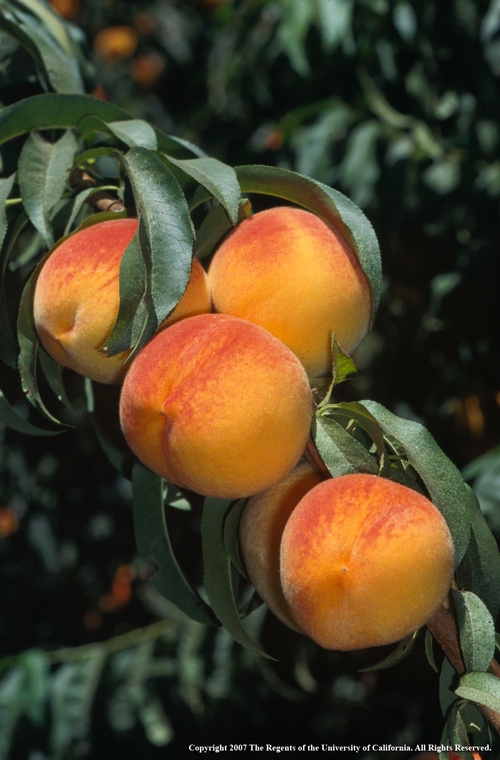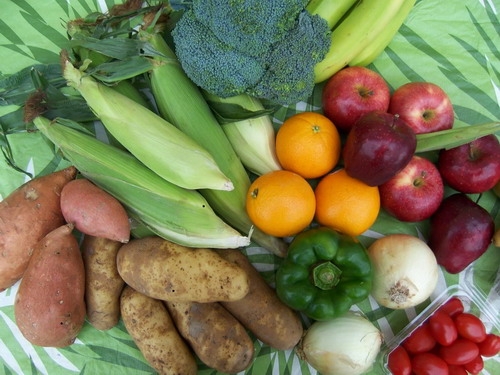Posts Tagged: fruit
It’s a scorcher! Beat the heat with healthy treats!
Summer time in the Central Valley means scorching temperatures in excess of 100 degrees, and sunshine that just won’t quit. When the thermometer heads north, we head to the freezer in search of a refreshing treat.
Can you remember devouring an ice cream cone in all its melting glory? Gobbling it up in search of refreshment as the sun’s rays seem to pierce right through you? Savoring each bite as the excess fat and sugar runs down the arm to the elbow, before dripping onto the asphalt with a sizzle.
Wait a minute. What was that about excess fat and sugar?
Unfortunately, not all refreshing treats are created equal. Frozen summer time staples like ice cream, though OK in moderation, can increase the amount of fat and sugar you’re consuming with little nutritional benefit.
Lucky for us, connoisseurs of summer time refreshments have tips and recipes to help us stay cool, the healthy way.
If it’s frozen treats you’re after, try:
Frozen grapes
Full of antioxidants and portable, frozen grapes make a great treat without a sticky mess.
Frozen cherries
Packed with vitamin C, cherries are an excellent summertime snack. Simply de-stem and rinse the cherries. Pit the cherries and spread on a tray. Place in the freezer until frozen. Store them in an air-tight container in the freezer until you are ready to pop a few to cool off.
Fruit smoothies
Fruit Smoothies are a favorite! Blend ½ c. vanilla low-fat soy or regular yogurt, ½ cup of your favorite fresh berries, 2 ice cubes and 2 tsp. vanilla extract until smooth. Makes one cup.
Healthy ice cream
This recipe has tofu; it is healthy and safe for those who are lactose intolerant.
Ingredients
12 ounces frozen strawberries or frozen peaches
14 ounces soft silk tofu
1 cup of sugar
2 ounces of a healthy oil
1 teaspoon lemon juice
1 teaspoon vanilla
Directions
1. Assemble ingredients and blend in a food processor or blender.
2. Next, place the mixture in a plastic freezer zipper bag (one quart size) and seal.
3. Place the healthy ice cream bag in a gallon size plastic bag filled with a couple of tablespoons of salt and plenty of ice and shake for five minutes. You will cool off just shaking the bags!
Remember, when the temperature rises, choose wisely. Healthy alternatives to fatty, sugary, frozen treats are simple and delicious!
Wishing you a cool and healthy summer! For more healthy tips, click here.
Reasons for the seasons
California residents not only enjoy an enviable climate and diverse regions, but also a wide selection of fresh produce year around.
As consumers, we want to stretch our food budget and provide a nutritious diet to our families; but we are not always sure about how to select the best fruits and vegetables, how to store them when we get home, new ways to serve them, and the nutrition benefits they offer.
Placer-Nevada Cooperative Extension has come to the rescue! As part of the Nutrition Best program, UCCE nutrition educators have prepared "Reasons for the Seasons - Produce tips for Placer County consumers," a series of seasonal produce handouts that provide practical information for families and children on purchasing, storing, preparing and serving locally grown seasonal produce.
Each handout also includes tips for families on the importance of family meals and snacks, a couple of tasty and easy-to-prepare recipes, and a coloring page for the children.
News & Information Outreach in Spanish has started to adapt into Spanish these handouts, and produced short video clips. The first one is for strawberries.
To tickle your interest, here is a sampling of some of the tips and information you'll find:
Apples – Over 7,000 varieties have been identified, however most consumers are only familiar with half a dozen or so varieties. Munching on an apple is a tooth cleaner and a gum stimulator. Apples may last up to three months if stored correctly.
Broccoli – Its name comes from the Latin word Brachium which means "branch" or "arm." Broccoli is one of the most nutritious vegetables you can eat. Instead of loading it with a cream sauce that is high in fat, try serving it with silvered almonds, sesame seeds, toasted bread crumbs or parmesan cheese. The leaves can also be eaten and contain more beta carotene than the florets. Store broccoli in an open plastic bag in the refrigerator vegetable drawer. For boiling or steaming, use a non-aluminum pot or pan. Aluminum seems to increase broccoli's cooking odors.
Cherries – Cherries are among the best foods for a snack. The riper the cherry, the larger the size, the deeper the color and the sweeter the fruit. Sour cherries are lower in calories and higher in vitamin C and beta carotene than sweet cherries. You can extend the cherry season by freezing them. They will keep for up to a year in your freezer.
Tomatoes - Botanically, tomatoes are a fruit. This is because, generally, a fruit is the edible part of the plant that contains the seeds, while a vegetable is the edible stems, leaves and roots of the plants. Tomatoes are the leading source of vitamin C in the American diet because of the quantities we eat. Store tomatoes at room temperature for up to one week; longer if still ripening.
Potatoes - Keep the potatoes in a burlap or a brown paper bag. Do not store onions with potatoes. The gases given off by onions accelerate the decay of potatoes and vice versa.
Melons – Most melons originated in the Near East. They are a good source of vitamin A, C and potassium. Serve melons slightly chilled; if they are too cold, you'll miss their full fragrance. Ripe melons are very fragrant, and the aroma of a cut melon can penetrate and effect other foods
Cauliflower – A good source of vitamin C, potassium and fiber. It has been associated with reducing the risk of cancer. Cauliflower should not be cooked in an aluminum or iron pot. It will turn yellow if cooked in an aluminum pot, and blue-green or brown if cooked in an iron pot.
Beets – Beets come in a glistening array of color, from garnet red, to red-white striped, to deep gold, to creamy white. The entire beet, from its robust and flavorful root to its buttery green top, is sweet and delicious. To maintain firmness, cut off beet greens before storing, but leave at least an inch of the stem attached.
May and June are cherry season, so why not look for new ways to enjoy this delicious and nutritious fruit?
Cherry salsa
1/4 cup dried cherries, coarsely chopped
1- 1/3 cups tart cherries, frozen
1/4 cup red onion, finely chopped
1 tablespoon jalapeños, diced
1 clove garlic, peeled and chopped
1 tablespoon fresh cilantro, chopped
1 teaspoon cornstarch
Coarsely chop cherries. Let cherries thaw and drain, reserving 1 tablespoon cherry juice. When cherries are thawed, combine drained cherries dried cherries, onion, jalapenos, garlic, and cilantro in a medium saucepan; mix well. Combine reserved cherry juice and cornstarch in a small bowl; mix until smooth. Stir into cherry mixture. Cook, stirring constantly, over medium-high heat until mixture is thickened. Let cool. Serve with tortilla chips.
This recipe can also be served over cooked chicken or pork
Southwestern-style cherry slaw
Yield: 6 -8 servings
Slaw:
4 cups shredded green cabbage
3 cups sweet cherries, pitted and halved
2 cups torn fresh spinach leaves
1 cup shredded jicama (optional)
1 cup shredded carrot
1/2 cup snipped fresh cilantro
1/2 cup diced red onion
1 avocado, peeled and diced
Toasted pine nuts for garnish
Dressing:
2 tablespoons olive oil
2 tablespoons fresh lime juice
2 tablespoons frozen lime juice concentrate, thawed
1 jalapeno pepper, seeded and minced
1/2 teaspoon lime zest
1/4 teaspoon each chili powder, ground cumin and salt
In large serving bowl, combine ingredients for Slaw. In small saucepan, combine Dressing ingredients; heat to boil. Pour over salad and toss gently to coat. Garnish with pine nuts and serve.
Recipe: Northwest Cherries Online
Keep your fruits and veggies tasting better longer
As you returned home from the market and unloaded your sack of produce, have you ever simply admired the satisfying bounty? Enjoyed the color, texture, and aroma as cantaloupe, broccoli, carrots, tomatoes, lettuce, cherries, apricots, avocado, strawberries and more passed through your hands? But now, what to do with each item … how best to keep it fresh and tasty until you’re ready to eat it?
The Postharvest Technology Center offers free copies of an 8.5” x 11” full color poster that shows which produce items should go in your refrigerator, which items should never go in the refrigerator, and finally, which items should be ripened at room temperature and then placed in the refrigerator.
“’Storing Fresh Fruits and Vegetable for Better Taste’ is a handy tool to keep on your refrigerator,” said Beth Mitcham, center director. “Where you store your produce can have a profound effect both on how good it tastes, and how long you can keep it at an optimal state until you’re ready to serve it to your family.”
Produce marketing researchers have noted that with the current recession, shoppers are feeling guiltier than ever when they end up having to toss out fruits or veggies ‘gone bad.’
“It’s like a double guilt,” explained Dr. Roberta Cook, “not only has the shopper with the best of intentions not eaten the food they know is healthiest for them, but they have also wasted their money. Following the handling recommendations for each produce item can really improve the consumer’s experience on several levels.”
Lychee: Good for the body, good for the farm
The sub-tropical fruit lychee could be a new crop for farmers along California's coast, according to Mark Gaskell, the UC Cooperative Extension advisor to small-scale farmers in Santa Barbara and San Luis Obispo counties.
A ping-pong-ball-sized tree fruit with white, jelly-like flesh, the red-skinned lychee is popular among Asian consumers. They appear to be adapted to roughly the same conditions as avocados, Gaskell said. Since the fruit is well accepted in areas where it is available, the potential market acceptability of lychees is high. And, demand for fresh lychees already exists in Asian markets that carry whole, frozen, unshelled lychees.
Nutritionists are also looking closely at the fruit, which is a rich source of dietary flavanols, according to UC Davis research nutritionist Robert Hockman.
Flavanols – found in strawberries, cocoa, red wine, green tea and lychees - provide improvements in the smooth lining of the vascular system, reduce blood pressure, reduce blood stickiness and possibly provide cognitive improvements, Hockman reports in a video recorded for UC’s website Feeling Fine Online.
However, studies have determined that, just because people eat flavanol-rich foods, it doesn’t mean the beneficial compounds get into the blood stream. Most flavanols, he said, are long-chain polyphenols, which are not well absorbed by the body.
In his research, Hockman is using a lychee fruit extract that has been processed to have smaller – more bioactive – molecules. The product was fed to rats and found to pass through the digestive tract and into the blood stream.
“Now we are moving on to human studies,” Hockman said.
He is specifically studying the lychee extract and vascular health in post-menopausal women.
“Cardiovascular disease is the No. 1 killer in California and the No. 1 killer in the U.S.,” Hockman said. “It represents enormous health care costs. California agriculture products may help reduce the risk (of cardiovascular disease), saving billions of dollars.”

Lychee (Photo: Wikimedia Commons)
It's blackberry and boysenberry pickin' time
Blackberries and boysenberries are amazing fruits. The fleeting fruit bearing nature of these productive plants are to be truly appreciated by pie and jam connoisseurs alike. Berries are a very low glycemic index foods (low in sugar) and a great treat for nutritionally conscious eaters.
Every gardener can enjoy and/or hate a productive berry plant. The fruit production is confined to a very short season but the plant can take on enormous proportions if left unchecked. One must be ever diligent to keep the berry plants confined to the planting row and kept trellised to avoid the “overgrown” berry heap in the backyard. Nonetheless, if a person has a place in the sun for a four-foot-wide row of berries, the rewards are terrific.
One can even plant them on south facing wal
l as long as you can put up a sturdy supporting trellis. If you live in a very hot summer climate, it may pay to cover your berry plants with a shade cloth, especially during ripening.From one plant you can harvest enough berries for a batch of delicious jam, or a luscious pie, some fruit for breakfast and, my favorite, blackberry popsicles (recipe to follow). After harvest, cut the berry canes that have already produced fruit back to the ground and trellis up those new canes growing up from the bottom. If you do that on an annual basis, you will keep the plants under control.
There are many varieties of berries and planting several with varying ripening periods spreads the harvest out over a longer time. Many varieties have a unique flavor, different from the “wild blackberry” that you may remember from the plant growing in the ditch. Some are thornless and easier to manage and others are quite thorny but the flavor is to die for.
Berries are divided into two groups: the trailing blackberries and erect blackberries. Trailing blackberries such as Boysen and Ollalie are popular varieties that are just now becoming ripe in Northern California. I have also been growing three of the erect cultivars that require a quite tall trellis - upwards of six to seven feet. But the fruit on these types are very large, and beautiful and the plants are vigorous and disease resistant. The varieties are “Black Satin," “Triple Crown” and “Cherokee.” These varieties will become ripe in another couple of weeks.
For more information on growing blackberries in your garden, visit the California Gardening website.
While you can use the berries in many ways, one that is truly a delight is to make blackberry popsicles. Here is the recipe:
Start by making a simple syrup by heating 2/3 cup of water to boiling, pour in 2/3 cup of white cane sugar and stir until dissolved. Remove from heat and allow to cool. Put three cups of washed fresh berries into a bowl and mash. You may want to strain out the seeds by pushing the fruit through a strainer, but you don’t need to. Blend with the cooled simple syrup. (You can also just put the berries into a blender with 2/3 cup of simple syrup.)
Pour the mixture into your popsicle mold and freeze for 3 to 4 hours. Insert the popsicle sticks and freeze 3 to 4 hours more. When frozen solid, take a popsicle in hand, mosey your way out to the garden, sit in a lounge chair in the shade and lick your troubles away.














